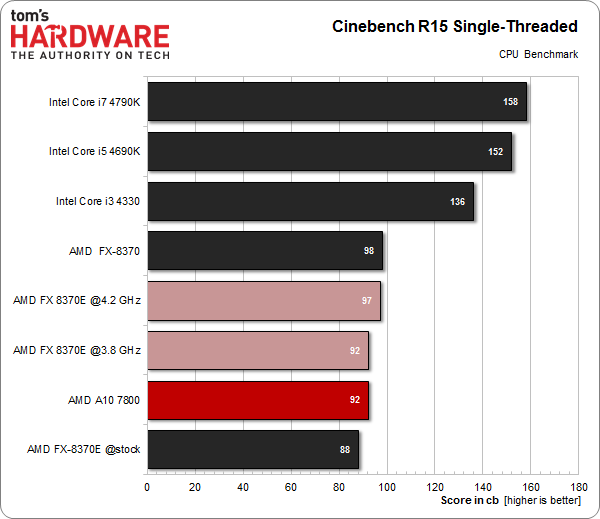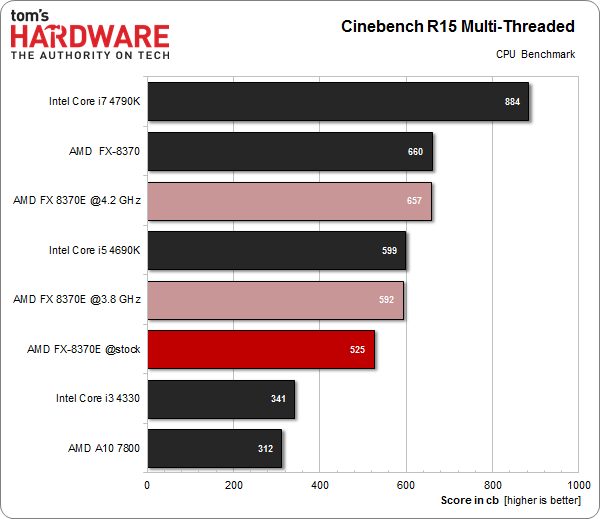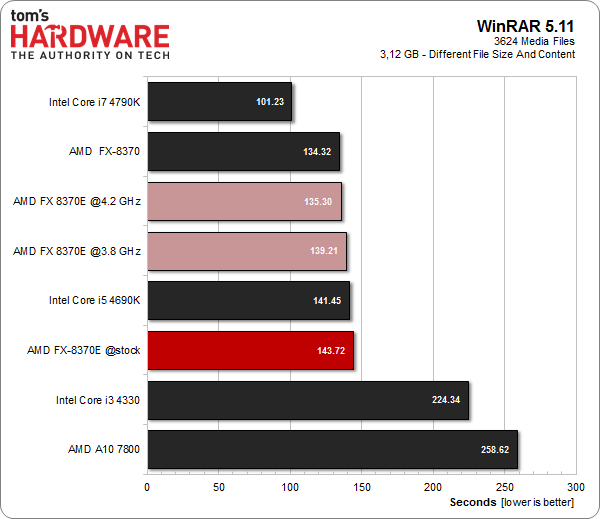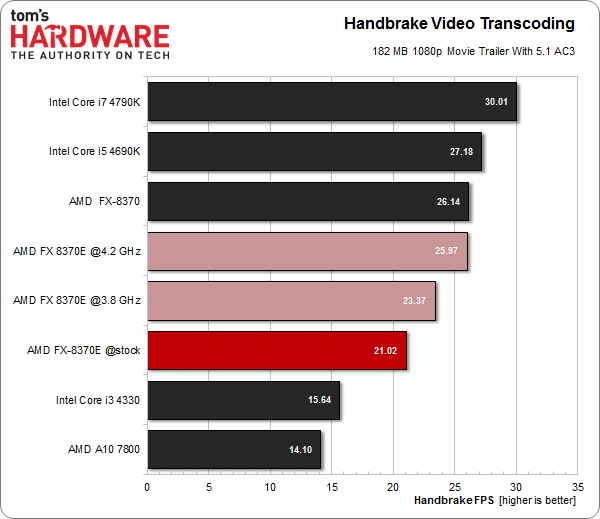AMD FX-8370E Review: Pulling The Handbrake For More Efficiency
Going more slowly is more efficient. That’s what AMD must have thought when they designed its new FX-8370E processor, thus closing a gap in the company's line-up. We evaluate whether this CPU is really more efficient and what happens when we overclock it.
Results: Synthetics And Applications
We're adding five other CPUs to the mix for our performance comparisons. The FX-8370E represented at three different clock rates takes the total number of bars to eight. Intel’s Core i7-4790K hails from another price range of course, but we still wanted to show what a Haswell-based CPU also capable of scheduling eight threads can do.
Per-clock performance is AMD's most glaring problem area. What happens when an application runs on just one core? The outcome is demonstrated nicely by Cinebench's single-threaded benchmark.
It's made clear in this test that AMD’s new CPU runs at a lower clock rate. Taking scaling into account, we’re basically left with the same performance that AMD’s other FX processors offered. At 4.2 GHz, the FX-8370E nearly catches the non-E version. Haswell blows them both out of the water, though. AMD has nowhere to go but up, and it's a shame that we don't have a Steamroller-based eight-core chip to fold into our chart. The A10-7800 is as much representation as we get from AMD's most modern architecture.
The situation improves when all eight of the FX's integer cores are utilized. Comparing AMD to Intel's Core i7-4790K still yields an ugly outcome, but the Core i5 isn't able to keep up as well in this case.
Well-parallelized tasks tasks allow the CPUs able to handle more than four threads at a time to show off. This is another well-deserved high point for AMD’s new processor.
Unfortunately, real-world tasks typically aren't as dramatically optimized, so they knock AMD's FX-8370E back down to earth. At least the 4.2 GHz configuration almost keeps up with the non-E version.
We could have added more synthetic and application benchmarks, but they wouldn't change the bottom line. Over the past few years, we've covered the Piledriver architecture in much depth, including this Vishera-based implementation. At any given frequency, we know how these CPUs fare, and that won't change due to an optimization for power consumption.
Get Tom's Hardware's best news and in-depth reviews, straight to your inbox.
The AMD FX-8370E is an interesting option for processing-intensive applications able to exploit more than four cores. Then again, the competition sells even faster processors available at lower power ceilings, if you have more money to spend.
Current page: Results: Synthetics And Applications
Prev Page Gaming: 4.2 GHz Is A Sensible Ceiling Next Page Results: Gaming
Igor Wallossek wrote a wide variety of hardware articles for Tom's Hardware, with a strong focus on technical analysis and in-depth reviews. His contributions have spanned a broad spectrum of PC components, including GPUs, CPUs, workstations, and PC builds. His insightful articles provide readers with detailed knowledge to make informed decisions in the ever-evolving tech landscape
-
MeteorsRaining The price point is a deal breaker. Its a fairly good CPU for AMD builders, but can't give it the tag of budget builder, you get i5 non-K in that price. Its moving into a higher (cost wise) territory with weak arsenal.Reply -
The_Doc How to start a benchmark review? But of course, let's show how powerful is AMD in single core!Reply
I think we all get it Vishera isn't exactly wonderful in single core operations, but:
A) I have yet to see any software which requires A LOT of single core power, it's 2014, if something is still single-core, it probably doesn't need all that power or il old enough to make even Vishera good at it.
B) You are comparing a 2012 architecture to a 4790K, It's like comparing Pentium 4 to a Pentium G3258.
-
husker Article quote: "However, it's probable that AMD sent us a sample chosen specifically for this purpose. Plus, there is almost certainly variance from one -8370E to the next. And so it's hard to know if the FX-8370E is actually better."Reply
If you pre-suppose that your sample is tainted why bother to do the testing and the article in the first place. Perhaps this is a case where your should purchase the product of the shelf in order to better serve your readers. -
1991ATServerTower I would have liked to see a power consumption chart of the following cpus all clocked to 3.8GHz.Reply
8150, 8320, 8230e, 8350, 8370e.
That would demonstrate the improvements of Vishera over Bulldozer, as well as any improvements offered by binning. -
oxxfatelostxxo "If you pre-suppose that your sample is tainted why bother to do the testing and the article in the first place. Perhaps this is a case where your should purchase the product of the shelf in order to better serve your readers."Reply
1) almost every vendor does this, cpus, graphics, ect..
2) the chip they received is exactly what you get when you buy it off the shelf, however every cpu/gpu ect varies by a small amount. The vendors simply make sure that review sites get the top end of that group. In all honesty we are probably talking 3% performance from the majority at most. -
ShadyHamster Any chance the older 8320/50 could be tested at the same voltages and clock speeds to better compare power usage?Reply
My 8320 will happily run 3.5/3.6ghz @ 1.15v as long as turbo core is disabled. -
m32 I've had a few 8350's that needed 1.41-1.45v for 4.5. These E models needs less voltage compared to the originals when dealing with "moderate" overclocks.Reply
I will probably get the 8320E for my office computer during Black Friday. $140 is the price right now but I prefer $125 or less for an AMD CPU. -
Chris Droste for all we know a nice, process-refined 8350 is the exact same chip under the hood, they just clocked it down and gave it a new name. someone wake me when AMD starts to innovate desktop CPUs again.Reply -
hmp_goose While it's nice to see a sweet spot staked out for the OC, and really nice to hear about how much smaller the heatsink can be, what I'd like to see if the E OCs cooler/ less wattage then the two non-Es. I like to think a 8350 is better then a 8320 if you care about power consumption at all, and want to see if the trend continues with the 8370 & 8370E …Reply -
RedJaron Reply
Precisely, which goes right along with what Igor said:14227111 said:The price point is a deal breaker. Its a fairly good CPU for AMD builders, but can't give it the tag of budget builder, you get i5 non-K in that price. Its moving into a higher (cost wise) territory with weak arsenal.
Yes 4.5 GHz and higher is possible, but at a certain point you're going to spend too much on a beefy motherboard and high-end cooler, negating the value of overclocking outright.
Far too many people forget the whole cost of OCing a chip. Sure, a 4.5 83XX can slightly beat a stock i5, but at what cost? The 6300 is a far more compelling CPU for tweakers. If you're lucky on a few sales, you can get the chip, cooler, and mboard for the same $200. And as pointed out here, unless you're pairing it with a top-shelf GPU, you won't see any gaming benefits with a pricier platform.
This is AMD's latest offering. The Haswell refresh is Intel's latest offering. Whatever the products' pedigrees, why shouldn't the two latest SKUs be compared?14227240 said:B) You are comparing a 2012 architecture to a 4790K, It's like comparing Pentium 4 to a Pentium G3258.



